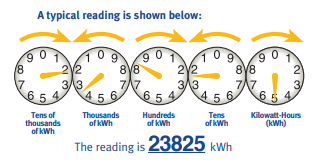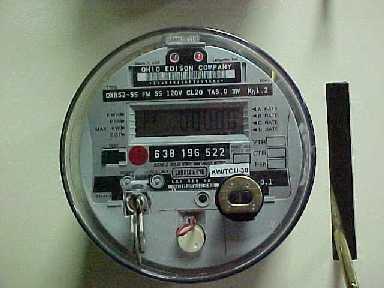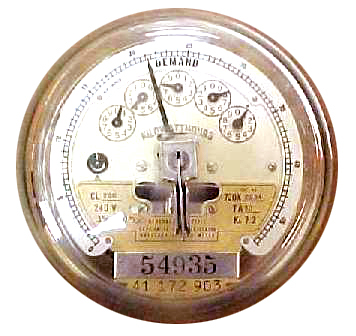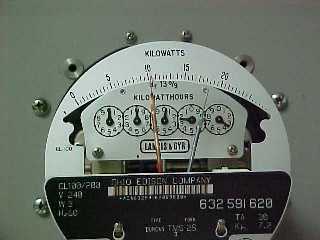Meter Reading
Reading your electric meter can tell you many things, such as the effect of a large new appliance on your consumption, how well you’re conserving energy, or even the effect of the weather on your usage. You may want to keep daily, weekly or monthly records. Our meter readers attempt to read your meter either monthly or bimonthly depending upon the established tariffs on file with each state. Below is information to help you better understand our meter reading process.
Meter Information
-
Meter Reading Schedules
Our meter readers attempt to read your meter either monthly or bimonthly depending upon the established tariffs on file with each state. The chart below shows whether your operating company is on a monthly or bimonthly schedule.
Meter Reading SchedulesOperating Company Meter Reading Ohio Edison Monthly The Illuminating Company Monthly Toledo Edison Monthly Met-Ed Monthly Penelec Monthly Penn Power Monthly West Penn Power Monthly Jersey Central Power & Light Monthly Mon Power Monthly Potomac Edison (WV) Monthly Potomac Edison (MD) Bimonthly
On the months that your meter is not read, your bill is estimated, which typically is based on daily usage from the same period during the prior year. Any difference between your estimated usage and actual usage is automatically adjusted the next time your meter is read.After the reading is obtained, it is entered into our computer system, which compares your reading with previous readings. If it is outside of the expected usage, the reading is flagged for closer examination by our Customer Accounting associates. Inaccurate estimated readings either are adjusted, or we obtain another reading.
We provide electricity to millions of customers and strive to deliver accurate bills every month. However, if you feel you’ve received a bill that is not accurate, you can read your meter and compare that reading with the one on your bill.
To submit your reading, you must enter it within a three-day window, which is listed under the "Messages" section on your bill, the month before a scheduled estimation. We will use your actual supplied reading to calculate your bill only if it is entered within this window. If you enter a reading outside of this window, we will prorate your bill using the reading you provided.
Unplanned Estimated Meter Readings
At times, severe weather conditions or other unforeseen circumstances might prevent us from reading your meter. On the months your meter is not read, your bill is estimated. If you prefer not to receive an estimated bill, you can login to submit a meter reading online or call our Customer Care Center.
-
Locating Your Meter
Your meter might be located inside or outside. If your meter is not mounted outside where the power lines come into your home, please check for your electric meter in your basement, laundry room, porch, garage, closet or attic.
If you live in an apartment building, duplex or other multiple-family dwelling, the meters for your building are grouped together in one place. Each meter should be labeled according to the unit it serves. Please make sure you read the correct meter. If the meters are not labeled, please check with your apartment manager or landlord to determine the correct meter for your dwelling. -
Meter Numbers
Your meter number is usually stamped or printed at the bottom of the face plate in bold black numerals and can be up to ten digits in length.
In order to utilize our Meter Read feature, please write down your meter number, along with your meter reading. These are required pieces of information needed in order to fill out the online meter read form. -
How to Read Your Meter
Reading your electric meter can tell you many things, such as the effect of a large new appliance on your consumption, how well you’re conserving energy, or even the effect of the weather on your usage. You may want to keep daily, weekly or monthly records.
How to Read Your Meter
You can read your meter to determine your hourly, daily, weekly or monthly use. Stand directly in front of your electric meter, with the meter at eye level. Most residential meters have four or five dials. Both types are read the same way. Each dial on the meter is numbered from 0 to 9 and has a pointer – like the hand on a clock – that turns either clockwise or counterclockwise. The pointers advance only when electricity is being used. These dials measure the number of kilowatt-hours (kWh) you use in 1s, 10s, 100s, 1,000s and 10,000s. To correctly read your meter, read the dials in order, starting from the right and moving to the left. Write down the numbers from right to left. In most cases, the pointer will be between two numbers on the dial. The correct number is the lesser of the two.

However, when the pointer appears to point directly at a number, use that number only if the pointer on the dial to the right has passed 0. Otherwise, use the lesser number.

In the illustration above, the pointer on dial B appears to be pointing directly at the number 4. Because the pointer on dial A has not passed 0, the number 4 on dial B should be read as 3.
To figure the number of kilowatt-hours you used during the month, subtract the last month’s reading on your most recent bill from the present reading. This will give the kilowatt-hours you used for the period. Follow these steps to determine your usage. The result will show how many kilowatt-hours of electricity you used and over what period you used them.
-
Meter Tests
We test all new electric meters before they’re installed to make sure they accurately register the electricity you use. These meters are also randomly tested after installation to ensure they operate properly. In the rare case that a meter is inaccurate, typically it’s because the meter has slowed down. If we find a defective meter, we repair or replace it and your bill is adjusted, based on your previous usage. Because of the employee time and expense involved, customers who request meter tests will be charged a fee. If the meter is found to be defective, the meter test fee is refunded.
Types of Meters
-
Electronic Load Meter
If your meter has an electronic digital display, we do not recommend attempting to read this type of meter yourself. Many factors are involved in determining an accurate bill for you, and many of these factors cannot be entered through our website. Our meter readers attempt to read your meter either monthly or bimonthly depending upon the established tariffs on file with each state. View the Meter Reading Schedules above for more information.

-
Mechanical Load Meter
If you use 1,000 or more kilowatt-hours of electricity per month, you may be able to reduce your monthly electric bill by taking advantage of our residential load management option. If so, your electric meter will have either an electronic digital display or an additional mechanical indicator called a load meter. These types of meters allow us to measure and record your highest peak demand for electricity each month.

You can read a mechanical load meter yourself. One type of load meter, shown here, has a large needle that moves along a calibrated scale around the meter face. The scale measures kilowatts (kW). The needle indicates the highest peak load since the meter was last read. As when reading the round dials, if the needle is between two marks the lower one is read. In this example, the needle registers 21 kW.

Another type of load meter has two large needles moving along a kilowatt scale. One needle indicates the highest 30-minute peak load since the last meter reading; the other needle, with a red tip, measures how much electricity is flowing into your home at the moment. As shown in this example, the load is currently 10.0 kW and the maximum 30-minute load was 18.5 kW. The load reading you would enter is 18.5.

This load meter uses three small dials, similar to the electric usage meter, to measure peak load. The vertical black line between the dials indicates the decimal point. Thus, this load meter reads 0.07 kW.
-
Smart Meters
A smart meter is a digital electric meter that collects electricity usage information and sends that data to the local utility through a secure telecommunications connection.
Smart meters provide a number of benefits. They reduce the number of estimated bills through automated readings, help us more quickly respond to power outages, and help customers learn more about their energy use. Plus, the smart meters we’re installing are UL certified and have been tested and proven by manufacturers to be safe and secure.
Select your state below for more information.

